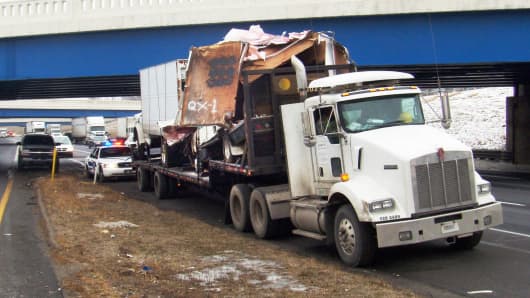Too-tall trucks have been hitting the too-low Virginia Avenue Bridge in downtown Indianapolis too often.
As many as 70 trucks have crashed into the bridge in recent years, causing transportation officials to mount a surveillance camera and finally a plan to lower the roadway and bring some peace to the smashed-up overpass.
The Virginia Avenue Bridge isn't the only one taking a beating, as several overpasses in the area have been clipped hundreds of times, according to the Indiana Department of Transportation.
While there has been concern the America's highway system is becoming less reliable and in need of repair—including a recent plea from President Barack Obama for infrastructure spending as part of his "grand bargain"—the Indianapolis bridge is not a poster child for the country's crumbling infrastructure. There is a different culprit at work.
Transportation officials last week released a video montage of surveillance footage, showing trucks slamming into the bridge over and over and over again. The video was released in hopes of fending off complaints from drivers, who will have to detour around the repairs for up to three months while the roadway is lowered below several bridges.
"More than 400 collisions have been recorded at seven city street bridges over the I-65/I-70 'South Split' since 1999, and the frequency and severity of vehicle-bridge strikes has increased in recent years," said Nathan Riggs, the spokesman for the Indiana Department of Transportation's Greenfield District.
Off-the-shelf global positioning systems may be the cause, said Sean McNally, spokesman at the American Trucking Associations. "We're not seeing increases in truck sizes or weights," McNally said in dismissing other factors. "Sometimes trucks wander where they're not supposed to be."
(Read more: Politicians fiddle while America's bridges decay)
Reports say GPS units elsewhere have directed too-trusting drivers into sloughs, atop mountains, into oncoming traffic, and to the edge of cliffs. And apparently they keep sending big trucks to the unluckiest bridge of all.



